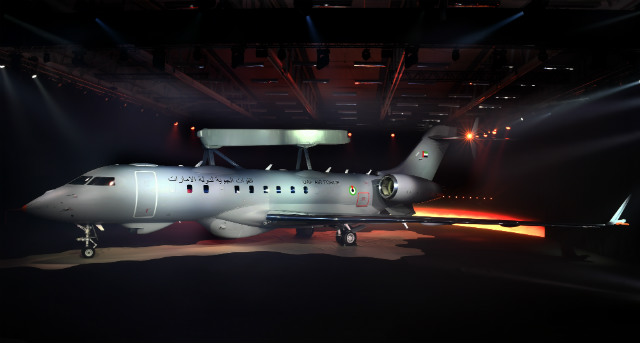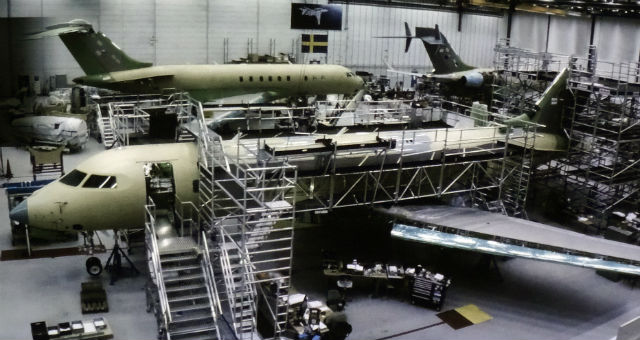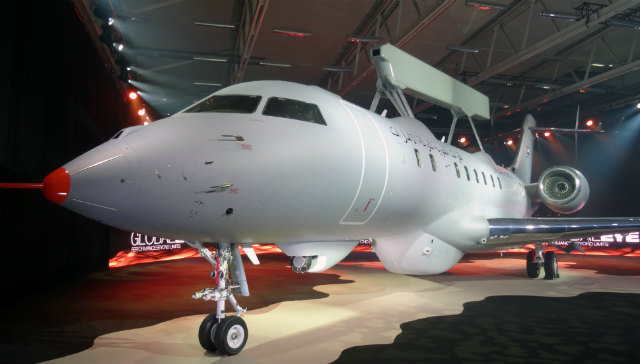Saab is poised to start ground-test activities with its first GlobalEye surveillance aircraft, having unveiled the heavily-adapted Bombardier Global 6000 for launch customer the United Arab Emirates.
Rolled out at the Swedish company's Linköping site on 23 February, the modified business jet is the first of three such "swing-role" platforms ordered by the Gulf nation since November 2015.
Revealed in UAE markings, the lead GlobalEye has its approximately 1t Saab Erieye ER airborne early warning (AEW) radar mounted atop the twinjet's fuselage. Additional sensors include a Leonardo Seaspray 7500E maritime surveillance radar – which also has synthetic aperture radar and ground moving target indication modes – and an electro-optical/infrared sensor, to be fitted underneath the forward fuselage.

Saab
"This aircraft is ready to commence testing – as soon as we are done here," Lars Tossman, head of airborne surveillance systems for Saab's surveillance business unit, said during the roll-out event.
Ground-based testing with the active electronically scanned array Erieye ER is already at an advanced stage in Gothenburg. While the sensor is contained within the same "skibox" fairing as previous versions of the radar, Saab says the use of new technology – including gallium nitride transmit/receive modules – provides a 70% increase in detection range. The company has previously cited a horizon-limited capability of 216nm (400km) for the new product, while operating at an altitude of 30,000ft.
Pointing to Saab's previous experience with installing the Erieye sensor on a trio of aircraft types, Mats Wicksell, head of systems integration, comments: "I expect to have a good performance from this system quite early in the programme."
Mission system testing is also being conducted in Gothenburg, as part of an integrated campaign with work spread across multiple Saab sites. "Today, all the equipment is integrated, to make a complete system," Wicksell adds.
Saab officials decline to reveal when the GlobalEye is expected to make its flight debut, or to detail the expected duration of its test campaign or delivery schedule. However, Wicksell says flight tests will be used "largely to validate the results in the final environment."
The UAE signed for two GlobalEye systems at the Dubai air show in November 2015, and exercised an option last year to add a third example. An image shown during the event showed that all three aircraft have entered the conversion process in Linköping, with Saab having secured a supplemental type certificate to modify the Canadian-built business jet.

After arriving at the site, each "green" Global 6000 undergoes extensive work, including airframe and wing strengthening to enable it to carry the Erieye array and other sensors, including wingtip-mounted electronic warfare equipment. An extended tailfin is also fitted, along with "finlets" and ventral strakes beneath the rear fuselage. Additional power and cooling equipment is also added, along with a self-protection suite comprised of laser and radar warning receivers, and countermeasures dispensers.
Other mission equipment includes data links, voice and satellite communications and a command and control suite with five onboard operator stations.
"The aircraft is a wonderful fit for what we are trying to achieve," says Wicksell.
Speaking in a video shown during the roll-out, UAE air force chief Ibrahim Naser Al Alawi described his service's coming capability as a "strong force multiplier".
"Our requirements for the future will consist of having an early warning radar which is capable also of detecting ballistic missiles, and to cover the whole domain as an air power," he says.

Craig Hoyle/FlightGlobal
Describing the GlobalEye's ability to perform simultaneous airborne, maritime and ground surveillance tasks as "absolutely unique", Tossman says the product is attracting strong interest from other potential buyers.
"A lot of nations are interested in this kind of capability," he says. "We have a lot of potential customers we are talking to." This includes existing Erieye operators, he says, along with "some countries without any [AEW] capability, or which have a rival system and are looking to increase their fleet".
Tossman refers to interest as coming from several nations in Asia, Europe and Latin America, and notes: "The NATO [Boeing E-3] fleet is going to be renewed around 2035".
"Today we have a customer base of eight countries – the biggest in the world," he says of Saab's sales success with the Erieye system. Flight Fleets Analyzer records Brazil, Greece, Mexico, Pakistan, Saudi Arabia, Sweden, Thailand and the UAE as currently flying a mix of adapted Embraer EMB-145s, Saab 340s and Saab 2000s.
The UAE's two Saab 340 AEW aircraft are operated with a radar technician but without onboard operators, and have their surveillance output downlinked to the ground. The company says the GlobalEye could potentially be used in such a way by some users.
But where onboard system operators are preferred, Torstein Bergli, Saab's product manager for airborne surveillance, says that the Global 6000 has a "very low noise level" and a 3,500ft cabin altitude pressure, both of which will reduce crew fatigue during missions of up to 11h.
While it scans for additional customers, Saab says it will be able to prepare up to three GlobalEye systems per year, and could commence deliveries within three years of receiving a contract. "We have had discussions with Bombardier on slots, and on how to shorten the lead-time when we are in need of more platforms," Wicksell says.
Source: FlightGlobal.com























